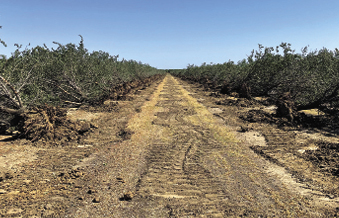
Sep 1, 2021California almond grower describes impact of limited water supply
Zero percent. Not a drop of agriculture’s most precious resource would be received this year.
That was the word given to our farm by the U.S. Bureau of Reclamation for how much surface water allocation we would receive this year. It’s not surprising given the dismal water year and tightening environmental constraints we continue to see. But once again, the reality of trying to farm with no surface water is maddening.
Due to water shortages and high-water costs, Woolf Farming, the company I work for in Fresno County, had to pull 383 acres of 15-year-old, prime, production almond trees. There simply was not enough water in the system to irrigate them. It was emotionally gutting to watch these trees bulldozed out of the ground, with this year’s crop already set.
To add insult to injury, we’re still paying over $100 an acre for water we are not receiving. That’s because infrastructure for the water still must be paid for, water or no water. Additionally, just to try to patch the year together, we need to buy some water on the open or spot market. That water is running between $1,200-$2,000 an acre-foot right now. The bulk of that water will not be delivered until this fall, after the growing season is over.
As a result, there’s a lot of food not being grown in the San Joaquin Valley’s west side this year, and 2022 is looking to be more painful. California is the nation’s plate, growing over two-thirds of America’s fruits and one-third of its vegetables, a lot of those from my backyard.
Woolf Farming was started back in 1974 by Jack and Bernice Woolf shortly after the completion of the Central Valley Project, which delivers federal water. Fresno County’s west side was known for growing grains, cotton and melons – primarily on groundwater – until the CVP was completed. This lifeline of surface water allowed our farm to greatly diversify our produce crops with processing tomatoes, almonds, pistachios, garlic and more. The CVP deliveries also allowed for reduced use of our groundwater, eliminating the undesirable effects now outlined in the Sustainable Groundwater Management Act.
Historically, our water allocations – and flows – were significantly more predictable. Even in a short water year such as this, there was still a basic allocation. But politics and regulations have reduced agricultural water supplies. Now, after the recent emergency water curtailments from the Sacramento-San Joaquin Delta watershed due to drought and failure to plan for the future, additional trees throughout the valley appear primed to be pulled as soon as harvest wraps up.
As a result of the curtailments, many other farmers and ranchers throughout the state are now enduring the pain we in the San Joaquin Valley have experienced throughout the past decade. The action will affect thousands of acres and over 6,000 farms. I am not the only one who has had to make agonizing decisions such as removing a valuable, productive orchard that result from these water cutbacks.
As we have seen all too often, agriculture faces policy actions that seem to extend beyond the science. It was terribly frustrating to see our own state go after us by suing on the recently updated biological opinions that govern the delta pumps. Protections for threatened and endangered species are still in place. Yet the new policies are significantly changing irrigation practices. Until 2020, operations and ecosystem decisions were tied to a calendar-based approach rather than using data and science we had learned from over the last several decades in the delta.
Think about that for a second: When you are making decisions about your livelihood, you walk the field inspecting the crop, monitor data inputs such as moisture probes and figure out where you are in the growing season. You don’t say, “Well, it’s June 18, I guess I should irrigate.” Yet, that is what was done for over a decade with our water supply.
As the saying goes, “The best time to plant a tree is 10 years ago. The second-best time is today.” That is how I feel about investments in our water infrastructure. While a decade ago, or two or three, would have been nice, we need to make those investments now. Our farms cannot wait another 10 to 20 years to break ground.
To quote the California Farm Water Coalition’s tagline, “Food Grows Where Water Flows.” It takes water to grow food – no matter where it’s grown in the world. We do it environmentally safer, with better human resource standards, fewer inputs and less of a carbon footprint than anywhere else in the world. Let’s figure out the solutions to how we can coexist with a healthy ecosystem and vibrant urban economy along with a productive agricultural community.
– Daniel Hartwig is a third-generation farmer in Fresno County and is the resource manager for Woolf Farming. He is president of Fresno County Farm Bureau. Article reprinted courtesy of the California Farm Bureau Federation.
Almond trees at Woolf Farming in Fresno County were bulldozed this year because there wasn’t enough water to irrigate them. More trees are expected to fall across the San Joaquin Valley. Photo: Daniel Hartwig







